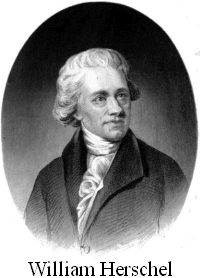¡SkyCaramba! weekly astronomy blog for the week ending April 19, 2014
 The astronomer famous for discovering Uranus also discovered something he couldn’t see. By accident, he took its temperature.
The astronomer famous for discovering Uranus also discovered something he couldn’t see. By accident, he took its temperature.
In 1800, William Herschel used filters of various colors to observe the sun. He found that a red filter let a lot of heat through. Wondering if different colors have different temperatures, he set up a prism to let the sun shine through and he placed thermometers in the color band on the other side. Indeed, the different colors did have different temperatures. The thermometers raised to different levels. The closer they were to the red end, the higher they climbed.
Familiar with scientific practices, Herschel also used one or two control thermometers placed away from the spectrum. With no sunlight shining on them, Herschel could make sure the sun and not something else in the room caused the temperature changes. What happened when he put a control thermometer near the spectrum, but not in it, surprised him.
Until then, the thermometer placed in the red light had registered the highest temperature. The one he put just past the red edge registered even higher. It would be reasonable today to view this as immediate proof that a form a light we can’t see transmits the heat. But in those days, scientists didn’t understand the relationship between light and heat. Hershcel’s correspondence with other scientists got them debating it. The light Herschel discovered became named infrared, which means “below red”.
![]() As scientists accepted that there is light we can’t see, inventors created photography. However, it wasn’t until the early 20th century that people figured out how to make film sensitive to infrared light. By the late 20th century, electronic light sensors used in digital photography could also detect infrared.
As scientists accepted that there is light we can’t see, inventors created photography. However, it wasn’t until the early 20th century that people figured out how to make film sensitive to infrared light. By the late 20th century, electronic light sensors used in digital photography could also detect infrared.
It’s also understood today that the sun shines beyond the purple end of the spectrum in frequencies called ultraviolet. Ultraviolet, or UV, causes sunburn and skin cancer.
And we’re still not done talking about all the energy the sun emits. Way below infrared, the sun emits microwaves. Many radar and satellite TV systems use microwaves and sometimes undergo interference from the sun. Way above ultraviolet, the sun emits X-rays which help charge the ionosphere enabling us to bounce radio signals around the globe. Occasionally, a solar flare emits gamma rays.
That entire spectrum from radio waves, to infrared, visible light, ultraviolet, X-rays, and gamma rays is called the electromagnetic spectrum. Because it’s all electromagnetic radiation, it all travels at the speed of light: 186,282 miles or 299,792 kilometers per second. Radio signals produced by distant stars take as long to reach us as the visible light from them.
In honor of Herschel’s discovery, the European Space Agency operates a space telescope that studies the skies in infrared. Because Earth’s weather and life generate so much infrared, astronomers cannot get infrared pictures of stars without putting a camera above the atmosphere.
Surely you already know that when you look to the sky there’s so much more than meets the eye. Now you understand that even when you see it, there’s more.
¡SkyCaramba!
http://coolcosmos.ipac.caltech.edu/cosmic_classroom/classroom_activities/herschel_bio.html